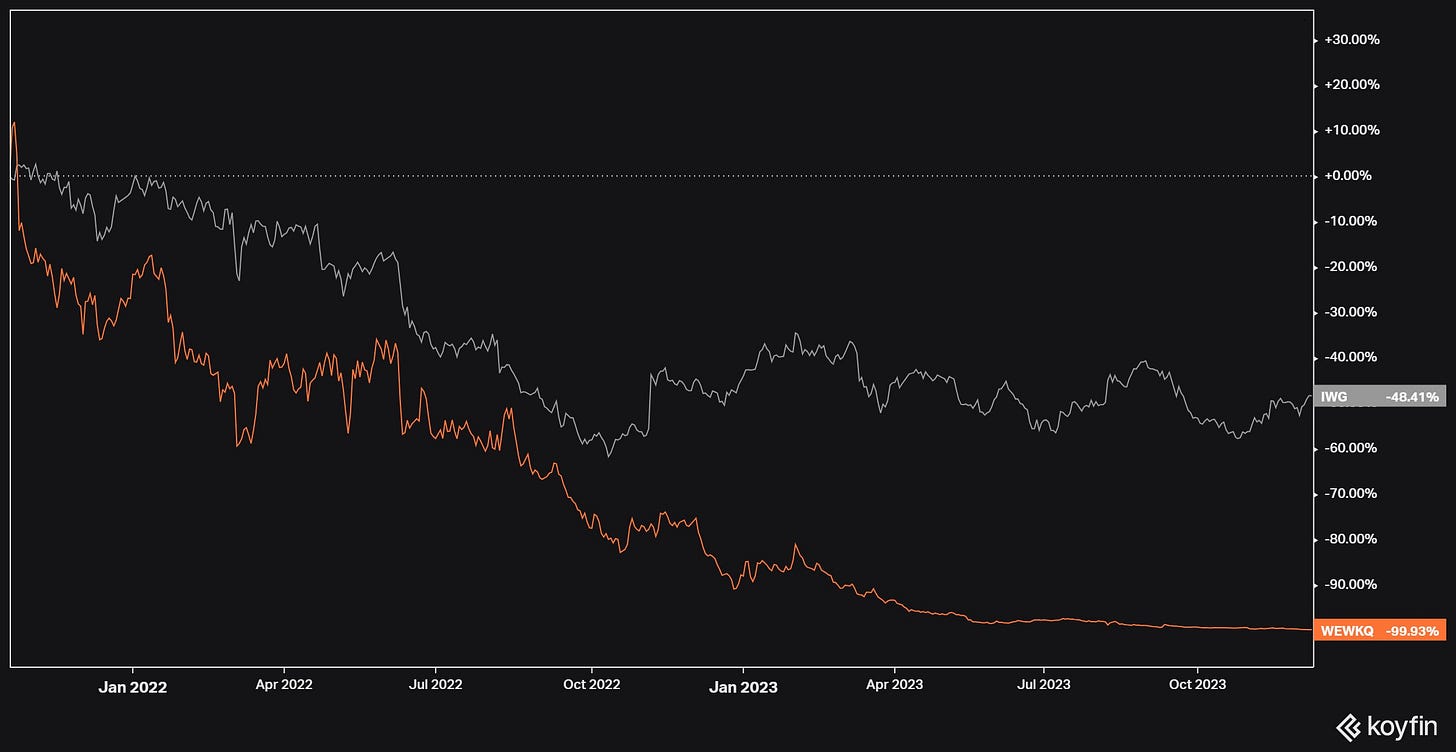WE didn't Work, but IWG does...
WeWork's failure is a catalyst for a re-rating of IWG Plc.
Disclaimer
Value Situations is NOT investment advice and the author is not an investment advisor.
All content on this website and in the newsletter, and all other communication and correspondence from its author, is for informational and educational purposes only and should not in any circumstances, whether express or implied, be considered to be advice of an investment, legal or any other nature. Please carry out your own research and due diligence.
“It was the best of times, it was the worst of times.”
A Tale of Two Cities, Charles Dickens.
Source: Bloomberg.
Source: Wall Street Journal.
The opening quote, set against recent news headlines, captures well the contrasting fortunes of flexible (or “flex”) office providers IWG Plc (IWG) and WeWork Inc (WEWKQ), but for those who might prefer a more visual representation the below chart perhaps best conveys how stark the contrast truly is:
Since its debut on the NYSE on 21 October 2021, WEWKQ (aka WE before it filed for Chapter 11 bankruptcy last month), has lost ~99.9% of its public market value, or approximately $9.2bn, an astonishing case of value destruction. Unfortunately, this only tells half the story, as the true extent of the value destruction is much worse in private-to-public value terms; WE was valued at $47bn back in 2019 in a Softbank-sponsored funding round, which implies a total collapse in value of $46.9bn and an effective wipe-out of the equity based on WEWKQ’s current market cap of ~$13m.
More incredible still is the fact that the recent Chapter 11 filing is not WEWKQ's first implosion. It previously botched a much-hyped IPO in September 2019, which in hindsight perhaps signaled the beginning of the end (it remains to be seen what might emerge from bankruptcy). Indeed the fact that WEWKQ’s going public was achieved not via a “box-office” IPO but by the more dubious route of a SPAC merger perhaps foreshadowed its eventual failure.
As an aside, looking back over WE/WEWQK’s boom-to-bust story I’d argue it can lay claim to the ignominious title of being the ultimate bubble company given it straddled perhaps the three most egregious market bubbles of the last market cycle – it was the posterboy of the VC/tech-unicorn bubble, the highest profile SPAC blow-up amid the SPAC boom of 2020/2021, and the highest profile casualty (to date) of the post-pandemic office CRE bust.
The background to WEWKQ’s downfall is well documented, spanning a movie, two books and countless financial media articles, and so it’s beyond the scope of this write-up to delve into what went wrong. However for those interested in the current bankruptcy process, I’d highly recommend reading Petition’s excellent discussion of the situation here and here.
By contrast, while IWG has endured challenges in the wake of the pandemic (and its stock price performance of -48% in the chart above certainly reflects that), its results YTD suggest it is now approaching an inflection point. For the H1-23 period, IWG reported record revenues, strong EBITDA growth of +51% YoY (net of lease expenses), and positive FCFE net of all capex and lease costs. Notably this very positive performance has occurred against a challenging backdrop for the office CRE market and as its main competitor WEWKQ imploded. While some commentators have pointed to WEWKQ’s difficulties as evidence of structural challenges facing both the office market generally and the flex office model specifically, IWG’s strong performance against such a backdrop suggests the market might be missing something with regard to the company’s prospects. Note IWG is valued at just ~6x EBITDA today compared to its long-term average multiple of ~7.5x, and its COVID period low of ~5x.
I believe WEWKQ’s collapse constitutes a new value catalyst for IWG given how it has been quick to capitalise on the former’s difficulties as it expands its office estate. IWG opportunistically acquired ~50 sites vacated by WEWKQ during H1 and has continued to add further sites through Q3. Furthermore, IWG has been adding these locations as part of its growing capital-light fee model rather than fixed term leases, which offers vastly superior economics, as I analyse below.
In simple terms, in an evolving office market with positive tailwinds for hybrid offices, significantly less competition following WEWKQ’s bankruptcy, and a likely inflection in earnings power from a shift to a capital-light model, it certainly seems a case of better times ahead for IWG. And that's before factoring in several idiosyncratic value-event catalysts for the stock.
With this context, let’s appraise the IWG situation in greater detail….




